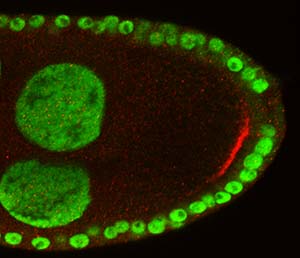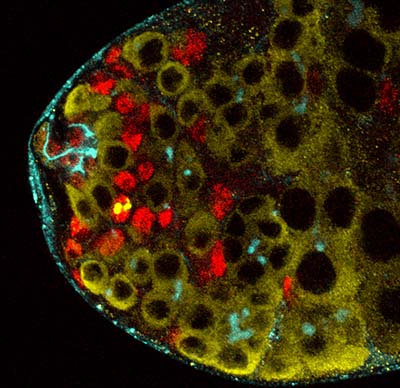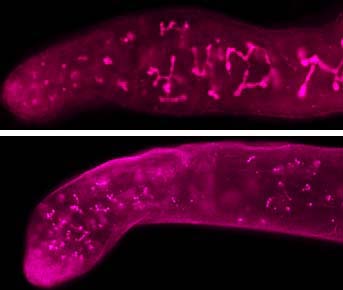|
||
Current Research Projects |
||
JAK/STAT signaling in oogenesis The JAK/STAT pathway is required for several independent events in oogenesis, including direct maintenance of somatic stem cells, function of somatic cells that support germline stem cell maintenance, two separate events specifying somatic follicle cell fates, and migration of the somatic border cells. This diversity of functions is accomplished in coordination with other signaling pathways and molecules. The mechanisms mediating JAK/STAT activity and the biological consequences in oogenesis are being investigated. |
|
 |
Regulation of the Upd morphogen The JAK/STAT pathway ligand Unpaired (Upd) acts as a classical morphogen to specify multiple cell fates in the follicular epithelium. Upd is secreted from cells at the anterior and posterior poles of each egg chamber to establish a gradient of Upd protein along the apical surface of the follicle cells. In turn, this creates a gradient of JAK/STAT activation within the follicle cells, leading to different cell fates at different levels of JAK/STAT activity. Because the absolute level of JAK/STAT activation is critical to proper follicular patterning, distribution of Upd must be carefully regulated. Recent work in the lab has shown that the heparan sulfate proteoglycan (HSPG) Dally is one factor that is important in regulating Upd distribution. However, the mechanisms by which HSPGs affect Upd distribution are not yet well understood. This has relevance for many morphogens, as a number of these in other sytems interact with HSPGs. |
JAK/STAT signaling in spermatogenesis As in oogenesis, JAK/STAT signaling is essential for maintenance of stem cell populations at the tip of the testis. Upd ligand is secreted by a cluster of somatic cells called the hub. This is needed directly in somatic stem cells to prevent their differention. JAK/STAT signaling is also needed to induce signals that maintain the germline stem cells and anchor them to the hub. We find that a second cytokine, Upd3, is also produced in the hub and are investigating its roles in spermatogenesis. In addition, we find that JAK/STAT signaling also affects later differentiation of spermatids. The nature of this requirement and how it fits in known developmental pathways in spermatogenesis are areas of interest in the lab. |
 |
 |
Genetic regulation of reproductive lifespan Aging is a universal biological process resulting in a progressive deterioration in cells, tissues, and biological function. Because of its high rate of activity and nonvital function, the Drosophila testis is an ideal system in which to examine aging. One functional measure of aging in the testis is reproductive lifespan, the length of time during which a male is fertile. While classical genetics has found many genes required for fertility, little is know about genetic contributions to reproductive longevity. We are using a genome-wide association study (GWAS) to identify genes important in maintenance of male fertility . This quantitative genetic approach will uncover naturally derived genetic variants that affect reproductive longevity which will be compared with those known to affect organismal longevity to determine the specificity in aging. Furthermore, effects of aging on testes in different genetic backgrounds will be characterized to determine whether reproductive senescence occurs in a consistent, predictable fashion or if there are multiple pathways to age-related failure of male fertility. |
Harrison Lab |
|||



